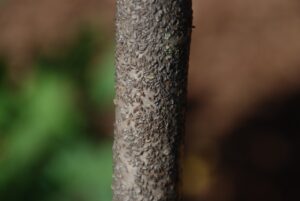Just like us, insects spend their winters in different locations. Unlike us, they spend their winters in different stages of development. Some may overwinter as adults, others in their immature stage as grubs, caterpillars, or nymphs, while others will be in the pupal stage like a chrysalis or cocoon. Understanding their lifecycle and location can help us support beneficial insects while managing problem insect pests.
Invite beneficial insects like lady beetles, parasitic wasps, and predatory mites to your landscape to help manage populations of plant-damaging pests. Add a birdbath to encourage insect-eating songbirds into your gardens. Most songbirds eat insects or feed them to their young while adding color, movement, and entertainment to your garden.
Keeping your plants healthy with proper care is the first and an important step in any pest management strategy. Healthy plants are better able to tolerate pest attacks and are more likely to recover from the damage.
Despite your best efforts, insect pests may attack and damage your plants. Birds and predaceous insects often manage small populations but there may be times you decide to intercede. Winter is a great time to monitor and, in many cases, manage plant-damaging insects.

Scale insects can be one of these and come in a variety of colors and shapes, but all grow and reproduce under a waxy covering. This covering protects them from predators, desiccation, and pesticides. Depending on the scale species they may overwinter as an immature scale, fertilized female, or eggs under the protective covering.
Treating plant damaging scale in late winter or early spring is one way to jump-start control of this pest while having minimal or no impact on beneficial insects that will help manage this pest. Take some time now to check plants for problem pests like the invasive oyster shell scale.
This insect is not native to North America and is a pest of more than 130 species of plants including poplars, ash, beech, maple, willows, dogwood, cotoneaster, and lilacs. Adult scale insects form a grayish to dark brown protective covering called a test that resembles an oyster or mussel shell. In the fall the mated female lays 20 to 100 eggs inside the test, dies and the eggs remain there throughout the winter.
Removing heavily infected twigs and branches is an option when the scale population is contained in a small portion of the plant. You can also gently scrape the scale off branches and stems with a plastic dish scrubber. Be careful not to damage thin-barked plants.
Another option is to apply organic lightweight horticulture oil like Summit Year-Roundâ Spray Oil when plants are dormant. The temperatures must be 40 degrees or higher when treating. As always, read and follow label directions for effective and safe control. Since the eggs are so well protected, a second application of the horticulture oil can increase success. Make a second application, if needed, when the eggs hatch and the immature insects known as crawlers emerge in spring after the buds have burst.
As you survey your landscape this winter, pay special attention to stressed plants and those susceptible to oystershell scale and other insect pests common in your area. Plants exposed to road dust and pesticides may also be more vulnerable as these conditions negatively impact predators and parasites that help manage plant pests.
Regularly monitoring plant health, working with nature, and strategically managing invasive pests like the oystershell scale can help improve the health, vigor, and longevity of your landscape plants.

Melinda Myers has written more than 20 gardening books, including the Midwest Gardener’s Handbook, 2nd Edition and Small Space Gardening. She hosts The Great Courses “How to Grow Anything” instant video and DVD series and the nationally syndicated Melinda’s Garden Moment TV & radio program. Myers is a columnist and contributing editor for Birds & Blooms magazine and was commissioned by Summit for her expertise to write this article. Myers’ website is www.MelindaMyers.com.
